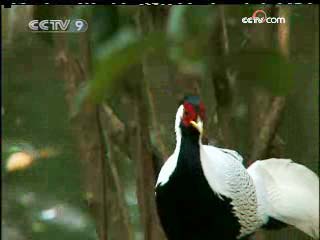------Program code: NS-080902-02089 (what's this?)
Source: CCTV.com
09-02-2008 10:02
The forest where the “Lord of the Firs” resides is a paradise for animals. The silver pheasant is only found south of the Yangtze River, and lives as a recluse in the forest at altitudes below 2000m.
 |
The male silver pheasant, having ensured there is no danger on the ground, urges his family to fly down.
 |
The silver pheasant, like other bird species, evolved from a reptile in ancient times. It has featured in verse in the poems of Li Bai, and its image appeared on official robes during the Ming and Qing Dynasties.
A male silver pheasant is over a meter tall and weighs more than 2kg. The silver pheasant is a sociable bird that lives together with its family.
A flock of silver pheasants has six to ten members, including several females and some young. The family head is always a strong and despotic male.
The male silver pheasant is both the head of the family and the lookout. The whole family act on his command.
When spring comes, the silver pheasant family can no longer find enough to eat on the mountain. So they have to move further down in search of food.
The silver pheasants chew on any stems and leaves they see.
The new leaves that have just grown on the little silver fir are in deadly peril. The female silver pheasant discovers the little silver fir. During the mating season, a male silver pheasant will use his beautiful plumage to court a female.
The female finally answers the mating call. She gives up the food in front of her in order to approach the male silver pheasant.
Inadvertently the male pheasant has saved the little silver fir.
A stretch of chinquapins and poplars are growing in the forest, a thousand meters above sea level. Their fruits contain a lot of sugar, and this attracts a number of silver pheasants.
The ancestors of the silver pheasant were good flyers. But their wings have degenerated over time, and now they are unable to fly up to the treetop to enjoy their feast. All they can do is wait for the ripe fruits to fall.
Before the fruit grow ripe, laying season arrives. The female silver pheasants, having won the attentions of the male, now seek out a secret place to lay their eggs. They will not return to the male until their young are hatched.
A female silver pheasant produces four to six young every year. A male lives for eight to ten years, and he can expect that at some point his authority as the family head will be challenged by one of his own offspring.
So, to protect his status, the male silver pheasant will eat every egg he can find.
A field station for silver fir research was set up in the ancient forest after the “Lord of the Firs” was discovered. The distance between the station and the “Lord of the Firs” as the crow flies is less than 2km. Yet it will take half a day to walk it.
Scientists have recreated a living environment similar to the home of the “Lord of the Firs”. They are hoping to find a means of artificially reproducing the tree.
Editor:Yang
